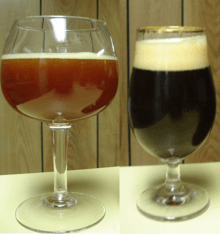Barley wine
Barley wine is a strong ale between 6-12% alcohol by volume.[1]
| Barley wine | |
|---|---|
 Barley wine ranges in colour from translucent deep amber, to cloudy mahogany (left), to near opaque black (right). | |
| Country of origin | England |
| Yeast type | Top-fermenting |
| Alcohol by volume | 6% - 12% |
| Color (SRM) | 8 - 22 (English) 10 - 19 (American) (24 - 48 EBC) |
| Bitterness (IBU) | 35 - 70 (English) 50 - 120 (American) |
| Original gravity | 1.080 - 1.120 |
| Final gravity | 1.018 – 1.030 (English) 1.016 – 1.030 (American) |
| Malt percentage | 100% |
History
In Ancient Armenia, a style of fermented grain beverage was referred to as "κρίθινος οἶνος" (krithinos oinos) - barley wine, by the Greek historian Xenophon, who mentioned to have experienced it, while being in Armenia, in his work Anabasis[2] and Polybius in his work The Histories. These barley wines would be dissimilar to modern examples as their mention predates the use of hops (a key component in modern barley wines) by several centuries.
_%D0%91%D0%90%D0%A1%D0%A1_%E2%84%961-_-_%D0%BB%D1%83%D1%87%D1%88%D0%B8%D0%B9_%D0%B7%D0%B8%D0%BC%D0%BD%D0%B8%D0%B9_%D0%BD%D0%B0%D0%BF%D0%B8%D1%82%D0%BE%D0%BA!.jpg)
The first beer to be marketed as barley wine was Bass No. 1 Ale, around 1870.[3]
The Anchor Brewing Company introduced the style to the United States in 1976 with its Old Foghorn Barleywine Style Ale.[4] Old Foghorn was styled as barleywine (one word) out of fear that occurrence of the word wine on a beer label would displease regulators.[5] In 1983, Sierra Nevada Brewing released Bigfoot Barleywine, becoming the second barley wine label in the United States.[6]
Characteristics
A barley wine typically reaches an alcohol strength of 6 to 12% by volume and is brewed from specific gravities as high as 1.120; equal to 320g/L of sugars. Use of the word wine is due to its alcoholic strength similar to a wine; but since it is made from grain rather than fruit, it is a beer. Breweries in the United States typically release it once a year during the autumn or winter.[6]
There are two primary styles of barley wine: the American which tends to be hoppier and more bitter, with colours ranging from amber to light brown[7] and the English style which tends to be less bitter and may have little hop flavour, with more variety in colour ranging from red-gold to opaque black.[8] Until the introduction of an amber-coloured barley wine under the name Gold Label by the Sheffield brewery Tennant's in 1951[9] (later brewed by Whitbread), British barley wines were always dark in colour.
The beer writer Michael Jackson referred to a barley wine by Smithwick's thus: "This is very distinctive, with an earthy hoppiness, a wineyness, lots of fruit and toffee flavours." He also noted that its original gravity is 1.062.[10]
Martyn Cornell was quoted as saying "no historically meaningful difference exists between barley wines and old ales". He later clarified, "I don’t believe there is actually any such meaningful style as 'barley wine'".[11]
Barley wines are sometimes labelled with a production date, as they are intended to be aged, sometimes extensively.[12]
Taxes and legal impediments
Many jurisdictions have different taxing schemes for potables based upon alcohol content. Since barley wine has a high alcohol content, it is, in some jurisdictions, taxed at a higher rate than other beers.[13] Thus, barley wines tend to suffer a further price premium as compared with other beers. Similarly, many jurisdictions have different regulations regarding where beers and wines can be sold, leading to confusion regarding in which category barley wines fall and therefore limiting access.
Wheat wine
A variation on the barley wine style involves adding a large quantity of wheat to the mash bill, resulting in what is referred to as wheat wine. This style originated in the United States in the 1980s.[14]
See also
- List of barley-based beverages
References
- "Barley wine", Michael Jackson
- Xenophon, Anabasis, 4.5.26, on Perseus
- Watts, Henry. A dictionary of chemistry and the allied branches of other sciences, Volume (1872).
- Holbrook, Stett (December 25, 2003). "Rich, chewy barley wine takes time". San Francisco Chronicle.
- Carter, Justin (2018-12-07). "Anchor Brewing | Old Foghorn Barleywine". PorchDrinking.com. Retrieved 2020-05-08.
- Jones, Kendall (Winter 2018). "The Rise and Fall (and Rise) of Barleywine". Sip Northwest. Winter 2018: 12.
- "Yeast Style Guide: American Barleywine". Wyeast Laboratories.
- "Yeast Style Guide: English Barleywine". Wyeast Laboratories.
- Cornell, Martyn. Amber Gold & Black, 2010, p168
- Jackson, Michael (February 1, 1993). "Brewery with its own abbey - it must be Ireland". What's Brewing.
- Cornell, Martyn (September 24, 2010). "So what IS the difference between barley wine and old ale?". Zythophile (blog).
- Tepedelen, Adem (Nov–Dec 2009). "A Winter's Ale". Imbibe. Retrieved 25 October 2013.
- "Skattesatser på alkohol". Skatteverket. Retrieved 4 June 2017.
- Bernstein, Joshua M. "Wheat of the Moment". Imbibe Magazine. Retrieved 12 January 2014.